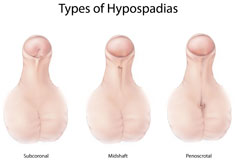Facts about Hypospadias
Hypospadias is a birth defect in boys in which the opening of the urethra (the tube that carries urine from the bladder to the outside of the body) is not located at the tip of the penis.
In boys with hypospadias, the urethra forms abnormally during weeks 8–14 of pregnancy. The abnormal opening can form anywhere from just below the end of the penis to the scrotum. There are different degrees of hypospadias; some can be minor and some more severe.
The type of hypospadias a boy has depends on the location of the opening of the urethra:
- Subcoronal: The opening of the urethra is located somewhere near the head of the penis.
- Midshaft: The opening of the urethra is located along the shaft of the penis.
- Penoscrotal: The opening of the urethra is located where the penis and scrotum meet.
Boys with hypospadias can sometimes have a curved penis. They could have problems with abnormal spraying of urine and might have to sit to urinate. In some boys with hypospadias, the testicle has not fully descended into the scrotum. If hypospadias is not treated it can lead to problems later in life, such as difficulty performing sexual intercourse or difficulty urinating while standing.
It is estimated that each year about 5 boys out of every 1,000 born in the United States have hypospadias.1
Did You Know?
Women can take steps before and during pregnancy to reduce the risk of having a baby born with birth defects. Such steps include taking a daily multivitamin with folic acid (400 micrograms), not smoking, and not drinking alcohol during pregnancy.
Learn more about how to prevent birth defects »
Causes and Risk Factors
Just like the many families affected by birth defects, CDC wants to find out what causes them. Understanding the risk factors that increase the chance of having a baby with birth defects will help us learn more about the causes. We are currently working on one of the largest U.S. studies to understand the causes and risk factors for birth defects called the National Birth Defects Prevention Study. This study is looking at many possible risk factors for birth defects, like hypospadias.
In recent years, CDC researchers have reported important findings about some factors that affect the risk of having a baby boy with hypospadias:
- Age and weight: Mothers who were age 35 years or older and who were considered obese had a higher risk of having a baby with hypospadias.2
- Fertility treatments: Women who used assisted reproductive technology to help with pregnancy had a higher risk of having a baby with hypospadias.3
- Certain hormones: Women who took certain hormones just before or during pregnancy were shown to have a higher risk of having baby with hypospadias.4
CDC continues to study birth defects like hypospadias and how to prevent them. If you are pregnant or thinking about becoming pregnant, talk with your doctor about ways to increase your chance of having a healthy baby.
Diagnosis
Hypospadias is usually diagnosed during a physical examination after the baby is born.
Treatments
Treatment for hypospadias depends on the type of defect the boy has. Most cases of hypospadias will need surgery to correct the defect.
If surgery is needed, it is usually done when the boy is between the ages of 3–18 months old. In some cases the surgery is done in stages. Some of the repairs done during the surgery might include placing the opening of the urethra in the right place, correcting the curve in the penis, and repairing the skin around the opening of the urethra. Because the doctor might need to use the foreskin to make some of the repairs, a baby boy with hypospadias should not be circumcised.
References
- Paulozzi LJ, Erickson JD, Jackson RJ. Hypospadias trends in two US surveillance systems. Pediatrics 1997; 100:831–834.
- Carmichael SL, Shaw GM, Laurent C, Olney RS, Lammer EJ, and the National Birth Defects Prevention Study. Maternal reproductive and demographic characteristics as risk factors for hypospadias. Paediatr Perinat Epidemiol. 2007; 21: 210–218.
- Reefhuis J, Honein MA, Schieve LA, Correa A, Hobbs CA, Rasmussen SA, and the National Birth Defects Prevention Study. Assisted reproductive technology and major structural birth defects in the United States. Human Rep. 2009; 24:360–366
- Carmichael SL, Shaw GM, Laurent C, Croughan MS, Olney RS, Lammer EJ. Maternal progestin intake and risk of hypospadias. Arch Pediatr Adolesc Med. 2005;159: 957–962
Contact Us:
- Centers for Disease Control and Prevention
National Center on Birth Defects and Developmental Disabilities
Division of Birth Defects and Developmental Disabilities
1600 Clifton Road
MS E-87
Atlanta, GA 30333 - 800-CDC-INFO
(800-232-4636)
TTY: (888) 232-6348
New Hours of Operation
8am-8pm ET/Monday-Friday
Closed Holidays - cdcinfo@cdc.gov




